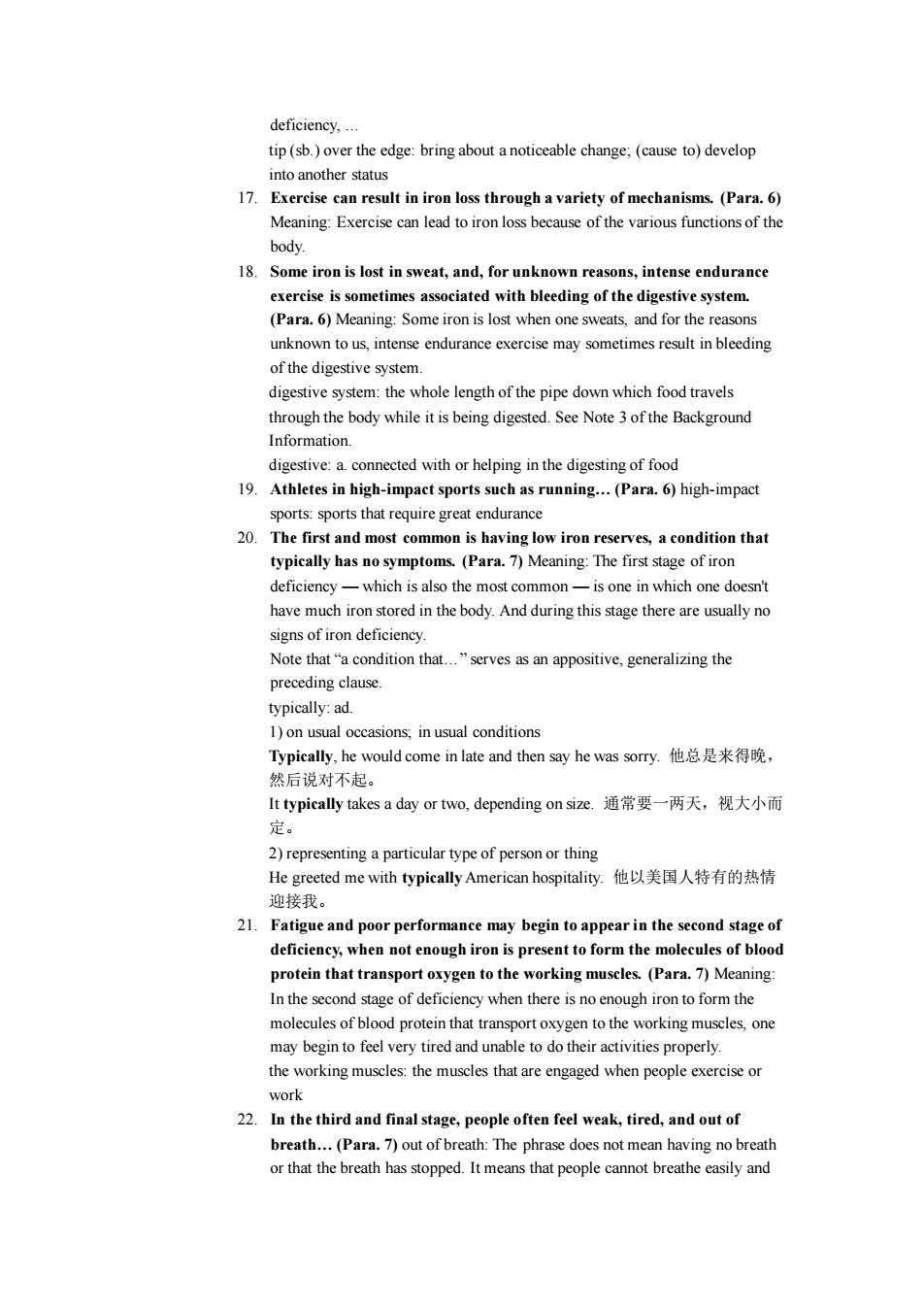
deficiency,tip (sb.)over the edge: bring about anoticeable change; (cause to) developinto another status17.Exercise can result in iron loss through a variety of mechanisms. (Para.6)Meaning:Exercise can leadto ironloss because ofthevariousfunctions of thebody.18.Some iron is lost in sweat, and, for unknown reasons, intense enduranceexercise is sometimes associated with bleeding of thedigestive system(Para. 6) Meaning: Some iron is lost when one sweats, and for the reasonsunknown to us, intense endurance exercise may sometimes result in bleedingof the digestive system.digestive system: the whole length of the pipe down which food travelsthrough the body while it is being digested.See Note 3 of the BackgroundInformation.digestive: a. connected with or helping in the digesting of food19.Athletes in high-impact sports such as running... (Para.6) high-impactsports: sports that require great endurance20.Thefirst and most common is having low iron reserves, a condition thattypically has no symptoms. (Para. 7) Meaning: The first stage of irondeficiency-which is also the most commonis one in which one doesn'thave much iron stored in the body.And during this stage there are usually nosigns of iron deficiency.Note that"a condition that..." serves as an appositive, generalizing thepreceding clausetypically: ad.1)onusualoccasions:inusual conditionsTypically,hewouldcomeinlateandthen sayhewassorry.他总是来得晚,然后说对不起。Ittypicallytakesadayortwo,dependingonsize.通常要一两天,视大小而定。2)representinga particular typeof person or thingHegreetedmewithtypicallyAmericanhospitality.他以美国人特有的热情迎接我。21.Fatigue and poor performance may begin to appearin the second stage ofdeficiency, when not enough iron is present to form the molecules of bloodprotein that transport oxygen to the working muscles. (Para. 7) Meaning:In the second stageof deficiencywhen there is no enough iron toform themolecules of blood protein that transportoxygen to the working muscles, onemay begin to feel very tired and unable to do their activities properly.the working muscles: the muscles that are engaged when people exercise orwork22. In the third and final stage, people often feel weak, tired, and out ofbreath...(Para.7)out of breath:The phrase does not mean having no breathorthat thebreathhas stopped.It means that people cannot breathe easily and
deficiency, . tip (sb.) over the edge: bring about a noticeable change; (cause to) develop into another status 17. Exercise can result in iron loss through a variety of mechanisms. (Para. 6) Meaning: Exercise can lead to iron loss because of the various functions of the body. 18. Some iron is lost in sweat, and, for unknown reasons, intense endurance exercise is sometimes associated with bleeding of the digestive system. (Para. 6) Meaning: Some iron is lost when one sweats, and for the reasons unknown to us, intense endurance exercise may sometimes result in bleeding of the digestive system. digestive system: the whole length of the pipe down which food travels through the body while it is being digested. See Note 3 of the Background Information. digestive: a. connected with or helping in the digesting of food 19. Athletes in high-impact sports such as running. (Para. 6) high-impact sports: sports that require great endurance 20. The first and most common is having low iron reserves, a condition that typically has no symptoms. (Para. 7) Meaning: The first stage of iron deficiency — which is also the most common — is one in which one doesn't have much iron stored in the body. And during this stage there are usually no signs of iron deficiency. Note that “a condition that.” serves as an appositive, generalizing the preceding clause. typically: ad. 1) on usual occasions; in usual conditions Typically, he would come in late and then say he was sorry. 他总是来得晚, 然后说对不起。 It typically takes a day or two, depending on size. 通常要一两天,视大小而 定。 2) representing a particular type of person or thing He greeted me with typically American hospitality. 他以美国人特有的热情 迎接我。 21. Fatigue and poor performance may begin to appear in the second stage of deficiency, when not enough iron is present to form the molecules of blood protein that transport oxygen to the working muscles. (Para. 7) Meaning: In the second stage of deficiency when there is no enough iron to form the molecules of blood protein that transport oxygen to the working muscles, one may begin to feel very tired and unable to do their activities properly. the working muscles: the muscles that are engaged when people exercise or work 22. In the third and final stage, people often feel weak, tired, and out of breath. (Para. 7) out of breath: The phrase does not mean having no breath or that the breath has stopped. It means that people cannot breathe easily and
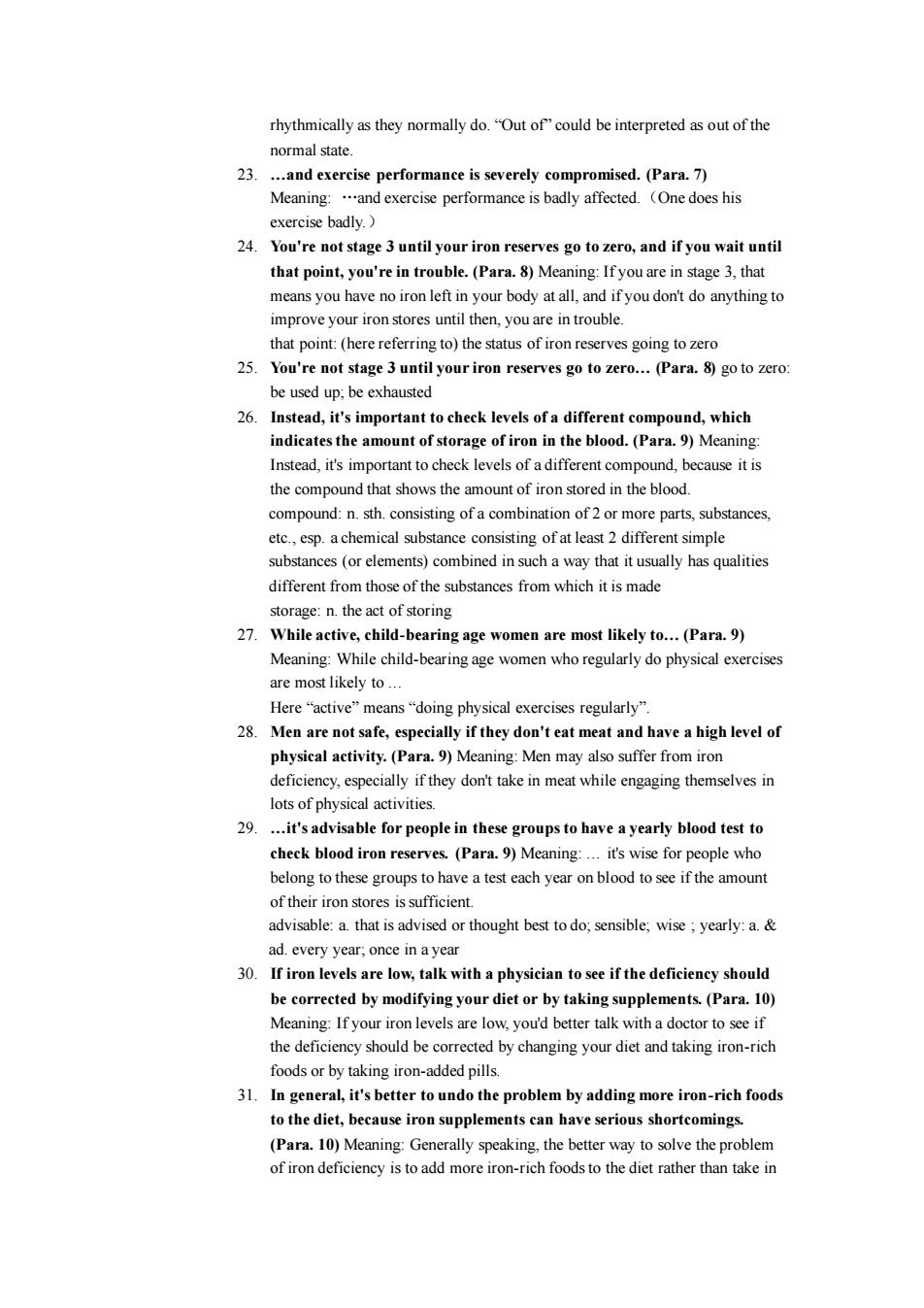
rhythmically as they normally do.“Out of"could be interpreted as out of thenormal state.23. ..and exercise performance is severely compromised. (Para. 7)Meaning:and exercise performance is badly affected.(One does hisexercisebadly.)24.You're not stage 3 until your iron reserves go to zero, and if you wait untilthat point, you're in trouble. (Para. 8) Meaning: If you are in stage 3, thatmeans you have no iron left in your body at all, and if you don't do anything toimprove your iron stores until then, you are in trouble.that point: (here referring to) the status of iron reserves going to zero25.You're not stage 3 until your iron reserves go to zero... (Para. 8) go to zero:be used up; be exhausted26.Instead, it's important to check levels of a different compound,whichindicates the amount of storage of iron in the blood. (Para.9) Meaning:Instead,it's importanttochecklevels of a different compound, because it isthe compound that shows the amount of iron stored in theblood.compound:n.sth.consisting of a combination of2or moreparts, substances,etc.,esp.a chemical substance consisting of at least 2 different simplesubstances (or elements)combined in such a way that it usually has qualitiesdifferent from those of the substances from which it ismadestorage: n. the act of storing27.While active, child-bearing age women are most likely to...(Para.9)Meaning: While child-bearing age women who regularly do physical exercisesare most likely to ...Here“active"means“"doing physical exercises regularly"28. Men are not safe, especially if they don't eat meat and have a high level ofphysical activity.(Para.9)Meaning:Men may also suffer from irondeficiency, especially if they don't take in meat while engaging themselves inlotsofphysical activities.29....it's advisable for people in these groups to have a yearly blood test tocheckblood iron reserves.(Para.9)Meaning:...it's wise for peoplewhobelong to these groups to have a test each year on blood to see if the amountoftheirironstoresissufficientadvisable: a. that is advised or thought best to do, sensible, wise , yearly: a. &ad.everyyear, onceinayear30.If iron levels are low, talk with a physician to see if the deficiency shouldbe corrected by modifyingyour diet or bytaking supplements. (Para.10)Meaning:If your iron levels arelow,you'd better talk with a doctorto see ifthe deficiency should be corrected by changing your diet and taking iron-richfoods or bytaking iron-added pills.31.In general, it's better to undo the problem by adding more iron-rich foodsto the diet, because iron supplements can have serious shortcomings.(Para.10)Meaning:Generally speaking,thebetter way to solve the problemof iron deficiency is to add more iron-rich foods to the diet rather than take in
rhythmically as they normally do. “Out of” could be interpreted as out of the normal state. 23. .and exercise performance is severely compromised. (Para. 7) Meaning: .and exercise performance is badly affected.(One does his exercise badly.) 24. You're not stage 3 until your iron reserves go to zero, and if you wait until that point, you're in trouble. (Para. 8) Meaning: If you are in stage 3, that means you have no iron left in your body at all, and if you don't do anything to improve your iron stores until then, you are in trouble. that point: (here referring to) the status of iron reserves going to zero 25. You're not stage 3 until your iron reserves go to zero. (Para. 8) go to zero: be used up; be exhausted 26. Instead, it's important to check levels of a different compound, which indicates the amount of storage of iron in the blood. (Para. 9) Meaning: Instead, it's important to check levels of a different compound, because it is the compound that shows the amount of iron stored in the blood. compound: n. sth. consisting of a combination of 2 or more parts, substances, etc., esp. a chemical substance consisting of at least 2 different simple substances (or elements) combined in such a way that it usually has qualities different from those of the substances from which it is made storage: n. the act of storing 27. While active, child-bearing age women are most likely to. (Para. 9) Meaning: While child-bearing age women who regularly do physical exercises are most likely to . Here “active” means “doing physical exercises regularly”. 28. Men are not safe, especially if they don't eat meat and have a high level of physical activity. (Para. 9) Meaning: Men may also suffer from iron deficiency, especially if they don't take in meat while engaging themselves in lots of physical activities. 29. .it's advisable for people in these groups to have a yearly blood test to check blood iron reserves. (Para. 9) Meaning: . it's wise for people who belong to these groups to have a test each year on blood to see if the amount of their iron stores is sufficient. advisable: a. that is advised or thought best to do; sensible; wise ; yearly: a. & ad. every year; once in a year 30. If iron levels are low, talk with a physician to see if the deficiency should be corrected by modifying your diet or by taking supplements. (Para. 10) Meaning: If your iron levels are low, you'd better talk with a doctor to see if the deficiency should be corrected by changing your diet and taking iron-rich foods or by taking iron-added pills. 31. In general, it's better to undo the problem by adding more iron-rich foods to the diet, because iron supplements can have serious shortcomings. (Para. 10) Meaning: Generally speaking, the better way to solve the problem of iron deficiency is to add more iron-rich foods to the diet rather than take in
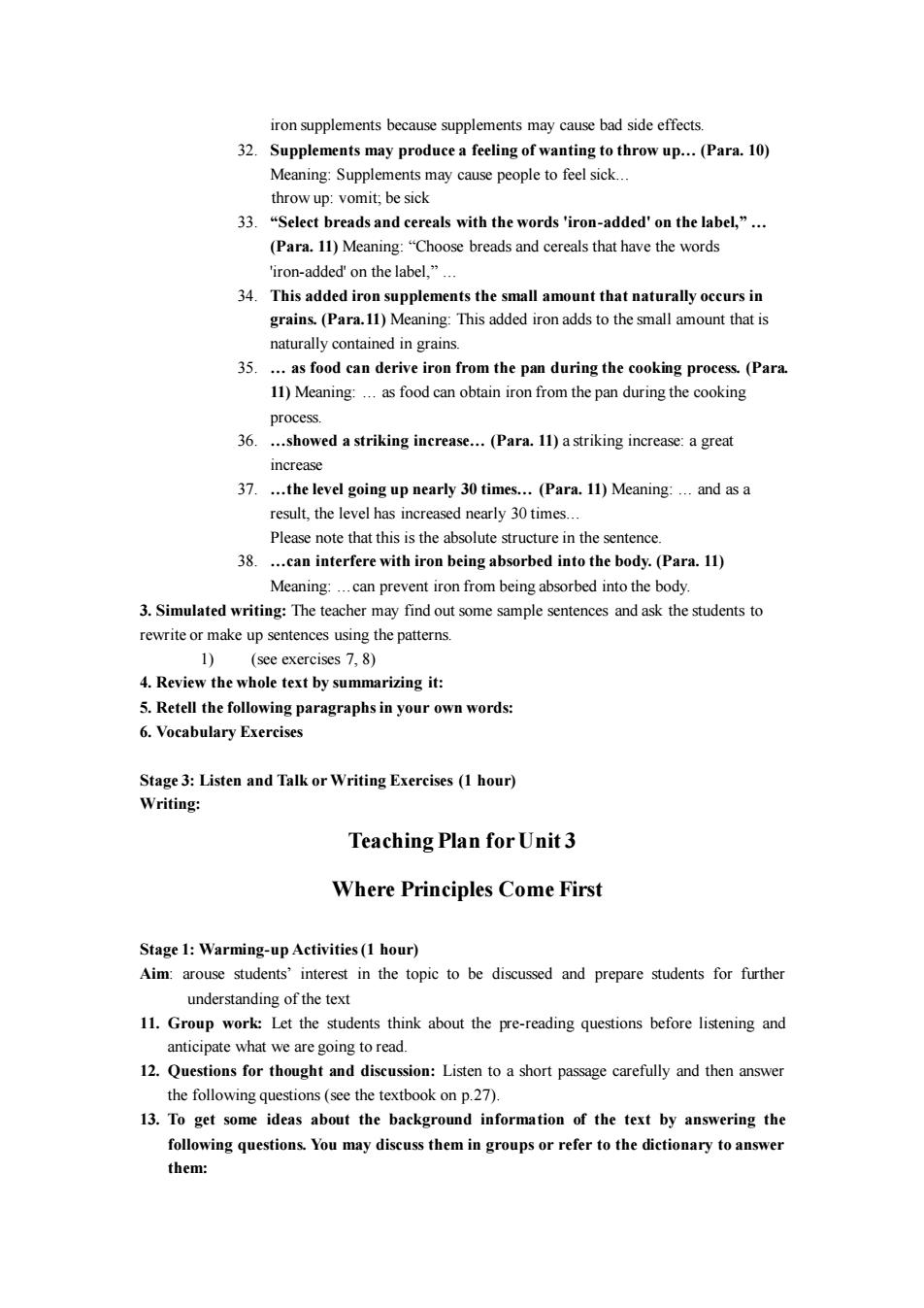
iron supplements because supplements may cause bad side effects32.Supplements may produce a feeling of wanting to throw up... (Para. 10)Meaning: Supplements may cause people to feel sick...throw up: vomit, be sick33."Select breads and cereals with the words iron-added' on the label," ..(Para.1l) Meaning:"Choose breads and cereals that have the words"iron-added' on the label,".34.This added iron supplements the small amount thatnaturally occursingrains. (Para.11) Meaning: This added iron adds to the small amount that isnaturally contained in grains.35.... as food can derive iron from the pan during the cooking process. (Para.11) Meaning: .. as food can obtain iron from the pan during the cookingprocess.36...showed a striking increase...(Para. l)a striking increase: a greatincrease37....the level going up nearly 30 times... (Para. 11) Meaning: ...and as aresult, the level has increased nearly30 times...Please note that this is the absolute structure in the sentence.38. ...can interfere with iron being absorbed into the body. (Para. 11)Meaning: ...can prevent iron from being absorbed into the body.3.Simulatedwriting:Theteachermayfindout some sample sentences andask the studentstorewriteor make up sentencesusing thepatterns.1)(seeexercises 7,8)4.Review the whole text by summarizing it:5. Retell the following paragraphs in your own words:6.VocabularyExercisesStage 3: Listen and Talk or Writing Exercises (1 hour)Writing:TeachingPlan forUnit3WherePrinciples ComeFirstStage l:Warming-up Activities (1 hour)Aim: arouse students' interest in the topic to be discussed and prepare students for furtherunderstanding of the text11.Group work:Let the students think about the pre-reading questions before listening andanticipate what we are going to read.12.Questions for thought and discussion: Listen to a short passage carefully and then answerthe following questions (see the textbook on p.27).13. To get some ideas about the background information of the text by answering thefollowing questions. You may discuss them in groups or refer to the dictionary to answerthem:
iron supplements because supplements may cause bad side effects. 32. Supplements may produce a feeling of wanting to throw up. (Para. 10) Meaning: Supplements may cause people to feel sick. throw up: vomit; be sick 33. “Select breads and cereals with the words 'iron-added' on the label,” . (Para. 11) Meaning: “Choose breads and cereals that have the words 'iron-added' on the label,” . 34. This added iron supplements the small amount that naturally occurs in grains. (Para.11) Meaning: This added iron adds to the small amount that is naturally contained in grains. 35. . as food can derive iron from the pan during the cooking process. (Para. 11) Meaning: . as food can obtain iron from the pan during the cooking process. 36. .showed a striking increase. (Para. 11) a striking increase: a great increase 37. .the level going up nearly 30 times. (Para. 11) Meaning: . and as a result, the level has increased nearly 30 times. Please note that this is the absolute structure in the sentence. 38. .can interfere with iron being absorbed into the body. (Para. 11) Meaning: .can prevent iron from being absorbed into the body. 3. Simulated writing: The teacher may find out some sample sentences and ask the students to rewrite or make up sentences using the patterns. 1) (see exercises 7, 8) 4. Review the whole text by summarizing it: 5. Retell the following paragraphs in your own words: 6. Vocabulary Exercises Stage 3: Listen and Talk or Writing Exercises (1 hour) Writing: Teaching Plan for Unit 3 Where Principles Come First Stage 1: Warming-up Activities (1 hour) Aim: arouse students’ interest in the topic to be discussed and prepare students for further understanding of the text 11. Group work: Let the students think about the pre-reading questions before listening and anticipate what we are going to read. 12. Questions for thought and discussion: Listen to a short passage carefully and then answer the following questions (see the textbook on p.27). 13. To get some ideas about the background information of the text by answering the following questions. You may discuss them in groups or refer to the dictionary to answer them:
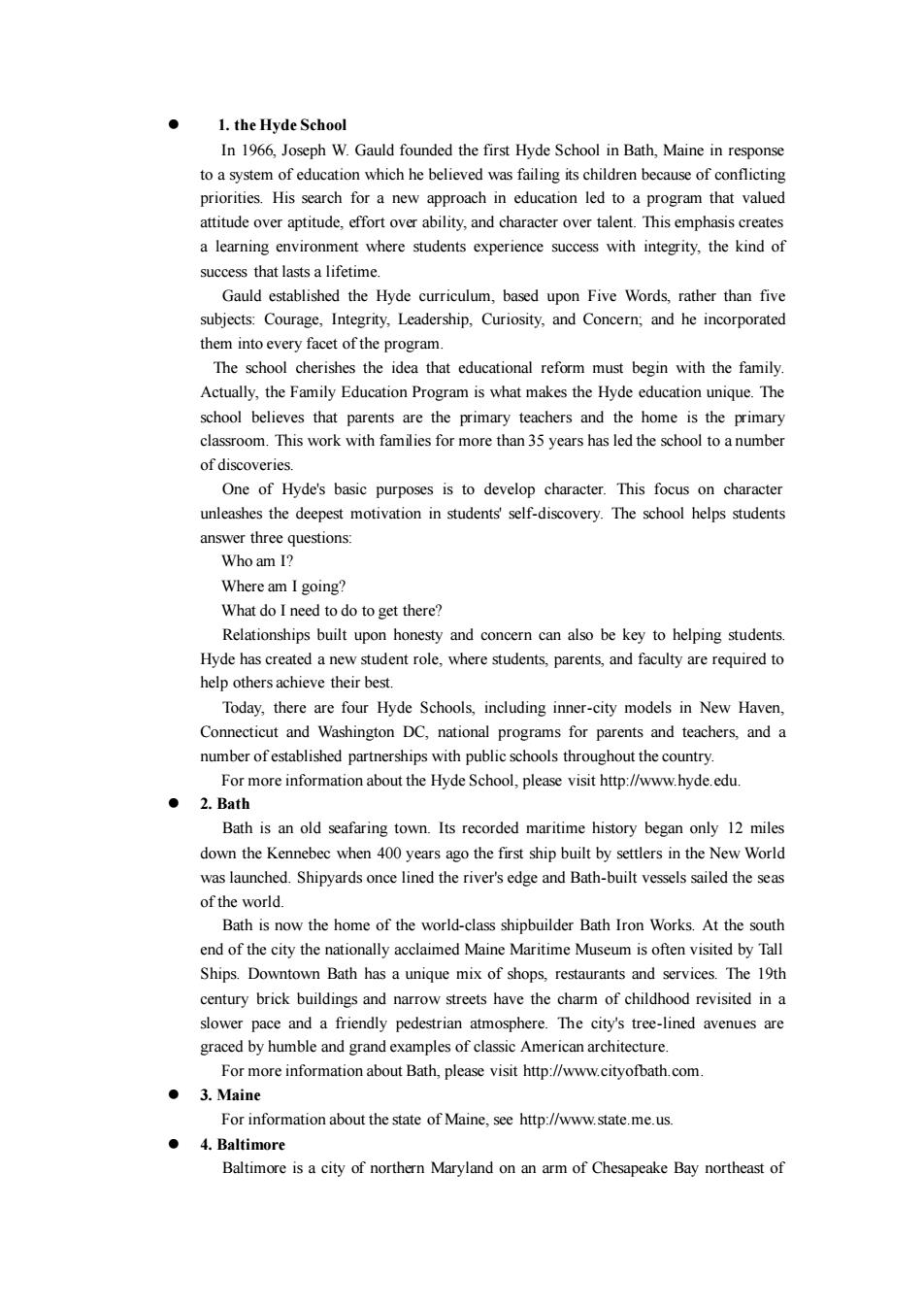
1.the Hyde SchoolIn 1966, Joseph W. Gauld founded the first Hyde School in Bath, Maine in responseto a system of education which he believed was failing its children because of conflictingpriorities.His search for a new approach in education led to aprogram that valuedattitudeover aptitude,effort over ability,and character overtalent.This emphasis createsa learning environment where students experience success with integrity,thekind ofsuccess that lasts a lifetimeGauld established the Hyde curriculum, based upon Five Words, rather than fivesubjects: Courage, Integrity, Leadership, Curiosity, and Concern, and he incorporatedthemintoeveryfacetoftheprogramThe school cherishes the idea that educational reform must begin with the familyActually,the FamilyEducation Program is what makes the Hyde education unique.Theschool believes that parents are the primary teachers and the home is the primaryclassroom.This workwithfamiliesformorethan35yearshas led the school toanumberofdiscoveries.One of Hyde's basic purposes is to develop character.This focus on characterunleashes the deepest motivation in students self-discovery.The school helps studentsanswer three questions:Who am I?Where am I going?What do I need to do to get there?Relationships built upon honestyand concern can also bekeyto helping studentsHyde has created a new student role, where students, parents, and faculty are required tohelpothersachievetheirbest.Today, there are four Hyde Schools, including inner-city models in New Haven,Connecticut and Washington DC,national programs forparents and teachers, and anumber of established partnerships with public schools throughout the country.For more information about the Hyde School, please visit http:/www.hyde.edu2.BathBath is an old seafaring town. Its recorded maritime history began only 12 milesdown the Kennebec when 400 years ago the first ship built by settlers in the New Worldwas launched, Shipyards once lined the river's edge and Bath-built vessels sailed the seasof the world.Bath is nowthe home of the world-class shipbuilder Bath Iron Works. At the southend of thecitythe nationallyacclaimed MaineMaritime Museum is often visited byTallShips. Downtown Bath has a unique mix of shops, restaurants and services.The 19thcentury brick buildings and narrowstreetshave thecharm of childhood revisited in aslower pace and a friendly pedestrian atmosphere. The city's tree-lined avenues aregraced by humble and grand examples of classic American architectureFormoreinformationaboutBath,pleasevisithttp://www.cityofbath.com,3.Maine8For informationaboutthestateof Maine,seehttp:/www.state.me.us4.BaltimoreBaltimore isa cityof northernMaryland onan armof ChesapeakeBaynortheast of
⚫ 1. the Hyde School In 1966, Joseph W. Gauld founded the first Hyde School in Bath, Maine in response to a system of education which he believed was failing its children because of conflicting priorities. His search for a new approach in education led to a program that valued attitude over aptitude, effort over ability, and character over talent. This emphasis creates a learning environment where students experience success with integrity, the kind of success that lasts a lifetime. Gauld established the Hyde curriculum, based upon Five Words, rather than five subjects: Courage, Integrity, Leadership, Curiosity, and Concern; and he incorporated them into every facet of the program. The school cherishes the idea that educational reform must begin with the family. Actually, the Family Education Program is what makes the Hyde education unique. The school believes that parents are the primary teachers and the home is the primary classroom. This work with families for more than 35 years has led the school to a number of discoveries. One of Hyde's basic purposes is to develop character. This focus on character unleashes the deepest motivation in students' self-discovery. The school helps students answer three questions: Who am I? Where am I going? What do I need to do to get there? Relationships built upon honesty and concern can also be key to helping students. Hyde has created a new student role, where students, parents, and faculty are required to help others achieve their best. Today, there are four Hyde Schools, including inner-city models in New Haven, Connecticut and Washington DC, national programs for parents and teachers, and a number of established partnerships with public schools throughout the country. For more information about the Hyde School, please visit http://www.hyde.edu. ⚫ 2. Bath Bath is an old seafaring town. Its recorded maritime history began only 12 miles down the Kennebec when 400 years ago the first ship built by settlers in the New World was launched. Shipyards once lined the river's edge and Bath-built vessels sailed the seas of the world. Bath is now the home of the world-class shipbuilder Bath Iron Works. At the south end of the city the nationally acclaimed Maine Maritime Museum is often visited by Tall Ships. Downtown Bath has a unique mix of shops, restaurants and services. The 19th century brick buildings and narrow streets have the charm of childhood revisited in a slower pace and a friendly pedestrian atmosphere. The city's tree-lined avenues are graced by humble and grand examples of classic American architecture. For more information about Bath, please visit http://www.cityofbath.com. ⚫ 3. Maine For information about the state of Maine, see http://www.state.me.us. ⚫ 4. Baltimore Baltimore is a city of northern Maryland on an arm of Chesapeake Bay northeast of
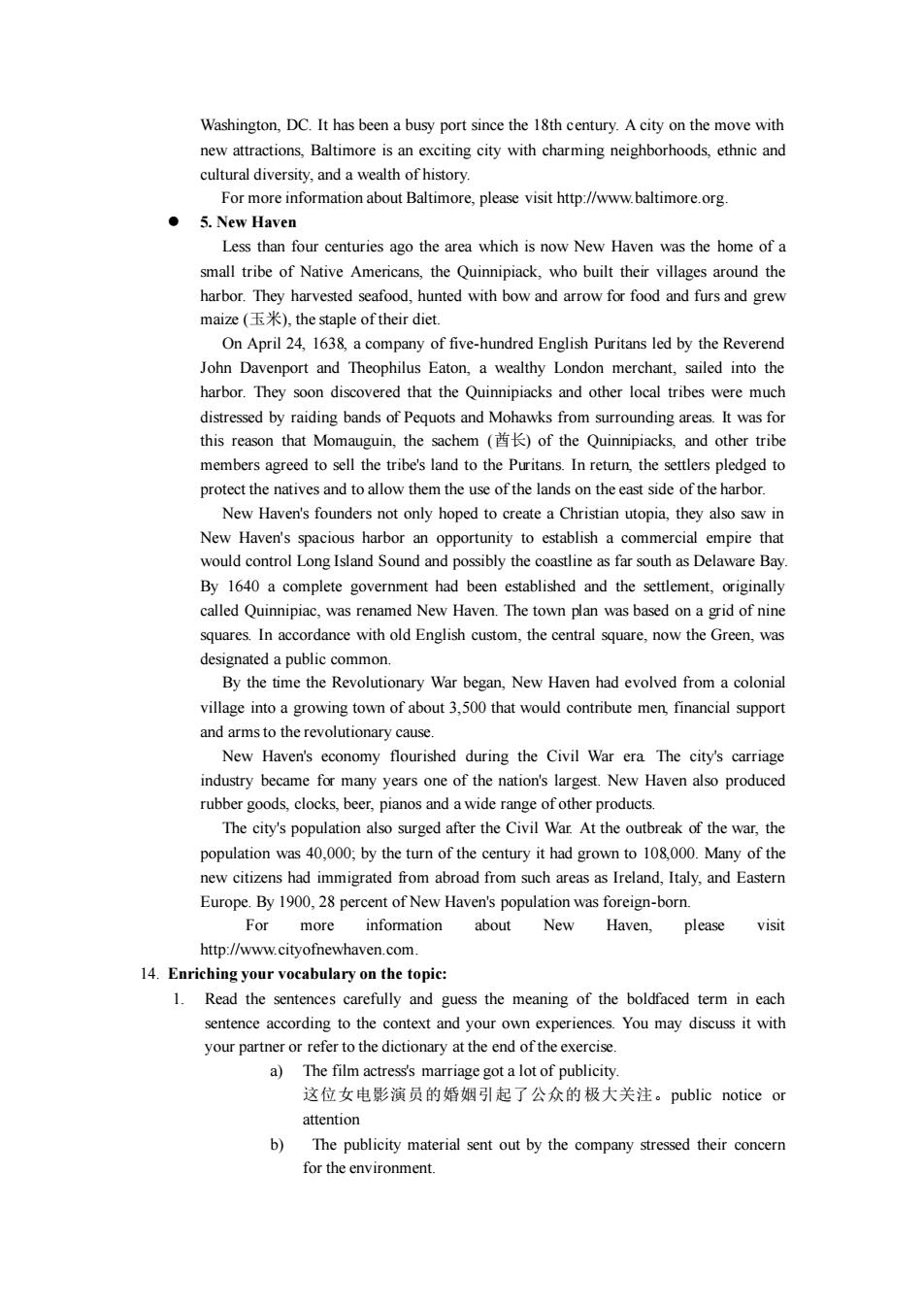
Washington, DC.It has been a busyport since the 18th century.Acity on the move withnew attractions, Baltimore is an exciting city with charming neighborhoods, ethnic andcultural diversity, and a wealth of history.Formore information aboutBaltimore,please visit http://www.baltimore.org5.NewHavenLess than four centuries ago the area which is now New Haven was the home of asmall tribe of Native Americans, the Quinnipiack, who built their villages around theharbor.They harvested seafood, hunted with bow and arrow for food and furs and grewmaize(玉米),thestapleoftheirdiet.On April 24, 1638, a company of five-hundred English Puritans led by the ReverendJohn Davenport and Theophilus Eaton, a wealthy London merchant, sailed into theharbor. They soon discovered that the Quinnipiacks and other local tribes were muchdistressed byraidingbands of Pequots and Mohawks from surrounding areas.It wasforthisreasonthatMomauguin,the sachem(长)of theQuinnipiacks,and othertribemembers agreed to sell the tribe's land to the Puritans. In return, the settlers pledged toprotect the natives and to allow them the use ofthe lands on the east side of the harbor.New Haven's founders not only hoped to create a Christian utopia, they also saw inNew Haven's spacious harbor an opportunity to establish a commercial empire thatwould control Long Island Sound and possibly the coastline as far south as Delaware BayBy 1640 a complete government had been established and the settlement, originallycalledQuinnipiac,was renamedNewHaven.Thetownplanwasbased onagrid of ninesquares.In accordancewithold English custom,the central square,nowtheGreen,wasdesignated a public common.BythetimetheRevolutionaryWarbeganNewHavenhadevolvedfromacolonialvillage into a growing town of about 3,500 that would contribute men, financial supportandarmstotherevolutionarycauseNew Haven's economy flourished during the Civil War era The city's carriageindustry became for many years one of the nation's largest. New Haven also producedrubbergoods, clocks, beer,pianos and a wide range of otherproducts.The city's population also surged after the Civil War At the outbreak of the war, thepopulation was 40,000; by the turn of the century it had grown to 108,000. Many of thenewcitizens had immigrated from abroad from such areasas Ireland, Italy,and EasternEurope.By1900,28percentofNewHaven'spopulationwasforeign-born.ForaboutNewHaven,pleasevisitmoreinformationhttp://www.cityofnewhaven.com.14. Enriching your vocabulary on the topic:Read the sentences carefully and guess the meaning of the boldfaced term in each1.sentence according to the context and your own experiences. You may discuss it withyour partner or refer to the dictionary at the end of the exercise.a)Thefilmactress's marriagegota lotofpublicity这位女电影演员的婚姻引起了公众的极大关注。publicnoticeorattentionb)Thepublicitymaterial sent out bythe company stressed their concernfor the environment
Washington, DC. It has been a busy port since the 18th century. A city on the move with new attractions, Baltimore is an exciting city with charming neighborhoods, ethnic and cultural diversity, and a wealth of history. For more information about Baltimore, please visit http://www.baltimore.org. ⚫ 5. New Haven Less than four centuries ago the area which is now New Haven was the home of a small tribe of Native Americans, the Quinnipiack, who built their villages around the harbor. They harvested seafood, hunted with bow and arrow for food and furs and grew maize (玉米), the staple of their diet. On April 24, 1638, a company of five-hundred English Puritans led by the Reverend John Davenport and Theophilus Eaton, a wealthy London merchant, sailed into the harbor. They soon discovered that the Quinnipiacks and other local tribes were much distressed by raiding bands of Pequots and Mohawks from surrounding areas. It was for this reason that Momauguin, the sachem (酋长) of the Quinnipiacks, and other tribe members agreed to sell the tribe's land to the Puritans. In return, the settlers pledged to protect the natives and to allow them the use of the lands on the east side of the harbor. New Haven's founders not only hoped to create a Christian utopia, they also saw in New Haven's spacious harbor an opportunity to establish a commercial empire that would control Long Island Sound and possibly the coastline as far south as Delaware Bay. By 1640 a complete government had been established and the settlement, originally called Quinnipiac, was renamed New Haven. The town plan was based on a grid of nine squares. In accordance with old English custom, the central square, now the Green, was designated a public common. By the time the Revolutionary War began, New Haven had evolved from a colonial village into a growing town of about 3,500 that would contribute men, financial support and arms to the revolutionary cause. New Haven's economy flourished during the Civil War era. The city's carriage industry became for many years one of the nation's largest. New Haven also produced rubber goods, clocks, beer, pianos and a wide range of other products. The city's population also surged after the Civil War. At the outbreak of the war, the population was 40,000; by the turn of the century it had grown to 108,000. Many of the new citizens had immigrated from abroad from such areas as Ireland, Italy, and Eastern Europe. By 1900, 28 percent of New Haven's population was foreign-born. For more information about New Haven, please visit http://www.cityofnewhaven.com. 14. Enriching your vocabulary on the topic: 1. Read the sentences carefully and guess the meaning of the boldfaced term in each sentence according to the context and your own experiences. You may discuss it with your partner or refer to the dictionary at the end of the exercise. a) The film actress's marriage got a lot of publicity. 这位女电影演员的婚姻引起了公众的极大关注。public notice or attention b) The publicity material sent out by the company stressed their concern for the environment